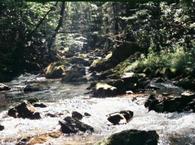
Spinners General Description:
Spinners are the adult mayflies that fly and mate high above the fast waters of the streams and you may not notice them. The Quill Gordon spinners can be recognized by the long tails and long front legs with the male having the longest legs and tails. After mating, the males are the first to fall followed by the females. The females however do not fall until their eggs have been deposited in the water. Most of the males will fall on the banks, but the females will mostly fall in the fast moving water.
The spinners will usually fall (notice I say usually often as there are exceptions) late in the afternoons but may start sooner if it is cloudy. Sometimes this spinner fall will occur just after a hatch ends, however it has been noted that they have fallen before the hatch ends. It is not obvious when the trout take them as they do so in a sipping manner leaving only the slightest ripple on the water. Since the spinner fall usually occurs in the late afternoon or during cloudy weather, and in fast moving water, it is not obvious what is occurring and it may go unnoticed.
After the spinners hit the water, the current will carry them into the current seams, where the trout will be waiting for them facing upstream. Again, this may not be obvious as the spinners will easily mix with the bubbles.
Spinner Presentation:
As the female spinners dip to the faster moving waters depositing their eggs, you can sometimes fool the trout by using by using a dun even though the spinners have the longer legs. This will often be successful since the spinners are falling on the faster water and the trout are not getting a good look at them. The presentation of the upright wing female spinner depositing her eggs should be the same as the presentation of any other dry fly.
Presenting a spent spinner is somewhat different in that they are presented below the ripples and runs in slower waters and edges along the banks, or in eddies. The current will collect the spent spinners in these slower waters. In this case the trout will have more time to analyze the fly so a good imitation of a spent spinner will be necessary.
As with duns or other dry flies, an up and across presentation will usually be the best approach. It must be drag free, so mend the line if needed. Keep your casts as short as possible using a longer cast only on occasions when a closer approach may not be available due to stream conditions. Use a light tippet perhaps a 6X with a leader of 10 or 12 feet for a delicate presentation.

See the new double sided fly boxes.
Bait/Lure Type:
Equipment:
Techniques:





